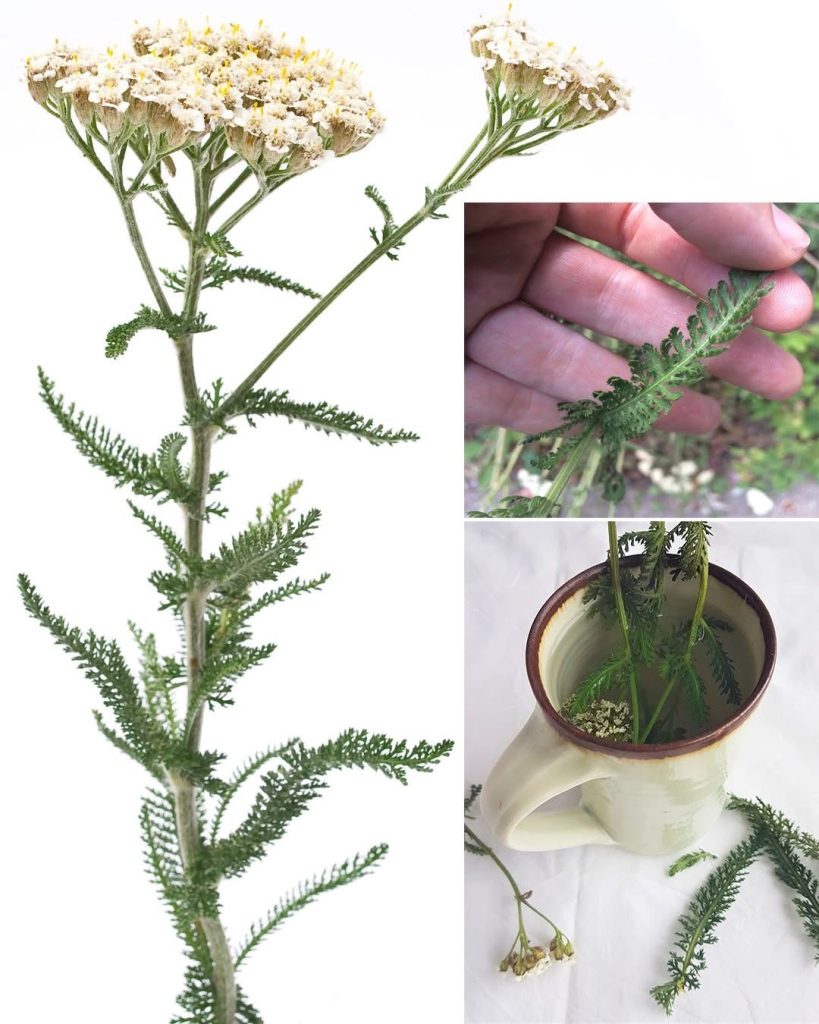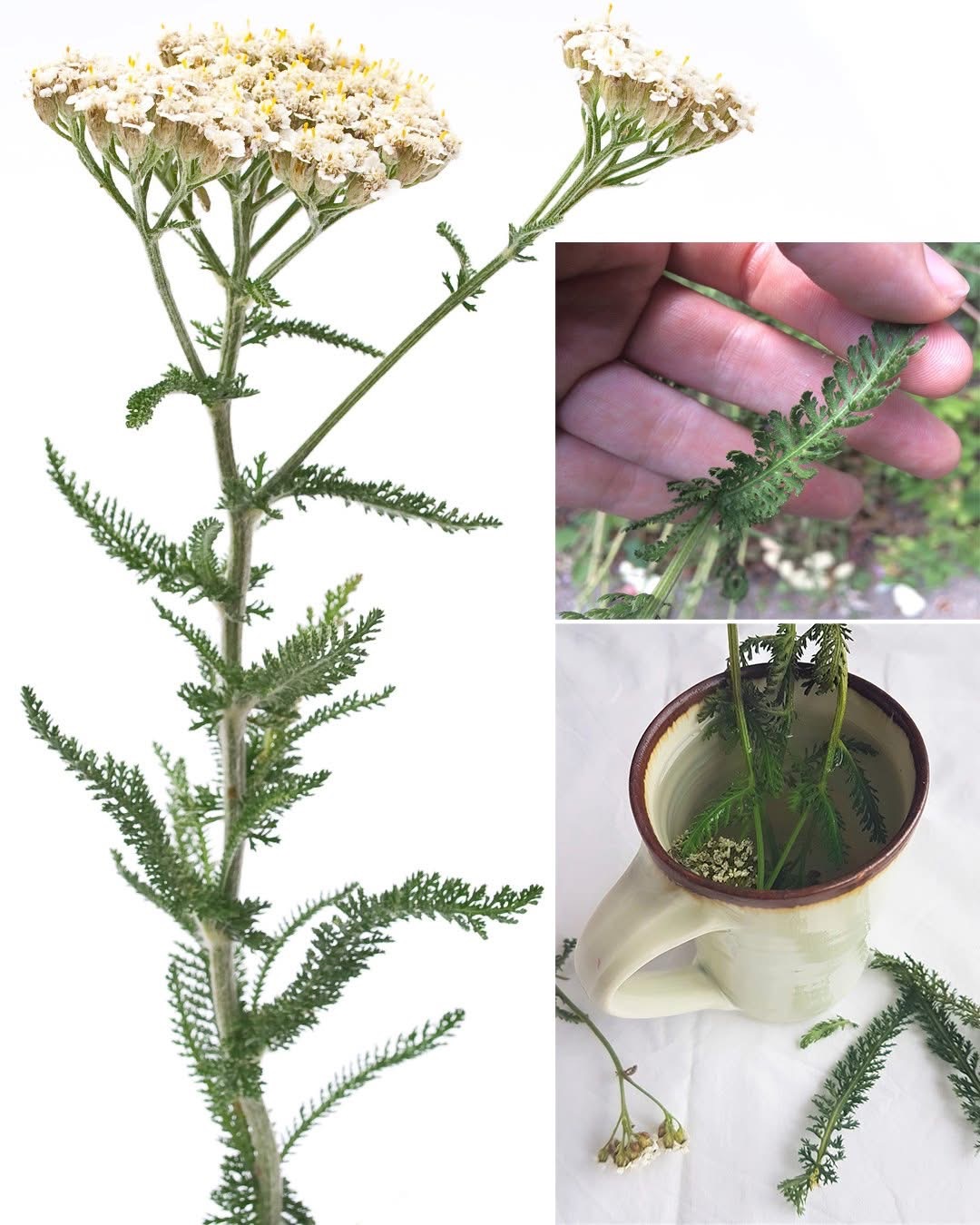
An In-Depth Exploration of Its History, Benefits, Uses, and Preparation
🌿
Botanical Overview
- Scientific Name: Achillea millefolium
- Common Names: Yarrow, Milfoil, Soldier’s Woundwort, Nosebleed Plant, Thousand-leaf, Carpenter’s Weed
- Family: Asteraceae (Daisy family)
- Habitat: Widely distributed in temperate regions of North America, Europe, and Asia. Found in grasslands, roadsides, meadows, and gardens.
- Plant Description:
- Height: Typically 30–90 cm (1–3 feet)
- Flowers: Small, tightly clustered, usually white or pale pink with a yellow center.
- Leaves: Feathery, finely divided, often described as “fern-like.”
- Stem: Erect, sometimes slightly hairy.
🌸
Historical and Traditional Uses
Yarrow has been revered since ancient times for its powerful healing properties:
- Ancient Greece: Legend says Achilles used yarrow to treat the wounds of his soldiers, hence the genus name Achillea.
- Native American Medicine: Used for fever, digestive issues, skin wounds, and to stop bleeding.
- European Folk Medicine: Traditionally used for colds, fevers, digestive support, and as a general tonic.
- Medieval Period: Carried as a charm for protection and used in “love divinations.”
🌱
Medicinal Properties
Yarrow is considered:
- Anti-inflammatory
- Antimicrobial
- Astringent
- Diaphoretic (induces sweating)
- Hemostatic (stops bleeding)
- Digestive stimulant
- Vulnerary (wound healing)
💊
Health Benefits of Yarrow
1.
Wound Healing
- Used topically to stop bleeding and promote the healing of cuts, abrasions, and ulcers.
- Contains alkaloids like achilleine, which contribute to blood clotting.
2.
Cold and Flu Support
- Yarrow tea induces sweating, helping break fevers.
- Often combined with elderflower and peppermint in traditional cold remedies.
3.
Digestive Aid
- Stimulates bile flow, improves digestion, and relieves bloating, cramps, and indigestion.
- Traditionally used for mild gastrointestinal distress.
4.
Menstrual Relief
- Helps regulate menstrual flow.
- Eases menstrual cramps due to its antispasmodic properties.
5.
Anti-inflammatory Effects
- Beneficial for reducing inflammation both internally (when consumed as tea) and externally (when applied as a poultice or wash).
6.
Antimicrobial Activity
- Historically used to prevent infection in wounds.
🍵
How to Use Yarrow
1.
Yarrow Tea (Infusion)
- Ingredients: Fresh or dried yarrow leaves and flowers.
- Preparation:
- Add 1–2 teaspoons of dried yarrow (or 2–4 teaspoons fresh) per cup of boiling water.
- Steep for 10–15 minutes.
- Uses: For colds, fevers, digestive issues, and menstrual discomfort.
2.
Yarrow Poultice
- Crush fresh leaves and flowers and apply directly to wounds to stop bleeding and promote healing.
3.
Yarrow Tincture
- Prepared by steeping fresh yarrow in alcohol for several weeks.
- Used for more concentrated internal or topical applications.
4.
Yarrow Bath
- Adding yarrow infusion to a warm bath can soothe skin irritations and muscle aches.
5.
Yarrow Salve
- Made by infusing yarrow in oil and combining it with beeswax to create a healing ointment for cuts, scrapes, and rashes.
⚗️
Active Constituents
- Alkaloids: Achilleine (promotes clotting)
- Volatile Oils: Azulene, camphor, cineole (anti-inflammatory and antimicrobial)
- Flavonoids: Apigenin, luteolin (antioxidant, anti-inflammatory)
- Tannins: Astringent, wound-healing
- Sesquiterpene lactones: Bitter compounds beneficial for digestion
⚠️
Safety and Precautions
- Pregnancy: Not recommended due to potential uterine stimulation.
- Allergies: People allergic to plants in the Asteraceae family (e.g., ragweed, daisies, chrysanthemums) may react to yarrow.
- Photosensitivity: Topical use can make skin more sensitive to sunlight in some people.
- Interactions: May interact with blood thinners, as yarrow also affects clotting.
Always consult with a qualified herbalist or healthcare provider before using yarrow medicinally, especially if pregnant, breastfeeding, or taking medications.
🌏
Cultural and Folklore Connections
- Divination: In some European traditions, yarrow stalks were used in I Ching readings.
- Protection Herb: Hung over doorways or carried to ward off evil.
- Love Magic: Used in spells and charms to attract love or determine one’s future spouse.
🌿
Yarrow in the Garden
- Pollinator-Friendly: Attracts beneficial insects like bees and ladybugs.
- Companion Plant: Improves the health of surrounding plants and repels some pests.
- Hardy Plant: Thrives in poor soil and dry conditions, making it easy to grow in many climates.
📝
Summary Table
| Feature | Details |
| Botanical Name | Achillea millefolium |
| Common Names | Yarrow, Soldier’s Woundwort, Nosebleed Plant |
| Key Benefits | Wound healing, fever reduction, digestive aid, menstrual support |
| Preparations | Tea, tincture, poultice, salve, bath |
| Active Compounds | Alkaloids, volatile oils, flavonoids, tannins |
| Cautions | Allergies, pregnancy, medication interactions |
💬
Final Thoughts
Yarrow is a potent medicinal plant that offers a wide range of health benefits, from first-aid applications to immune support. Its versatility, ease of preparation, and rich history make it
